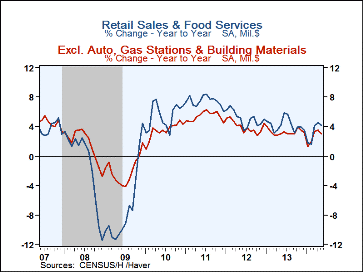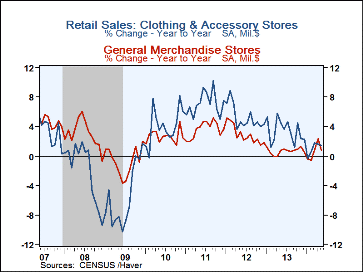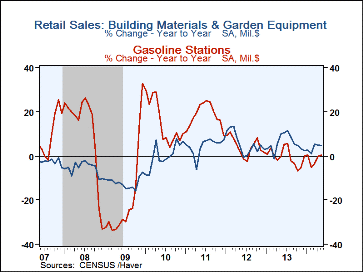 Global| Jun 12 2014
Global| Jun 12 2014U.S. Retail Sales Post Uneven Increases
by:Tom Moeller
|in:Economy in Brief
Summary
The improved labor market is spurring more consumer purchases. Retail and food service sales gained 0.3% during May following a 0.5% April advance, revised from 0.1%. A 0.5% increase had been expected in the Action Economics Forecast [...]
The improved labor market is spurring more consumer purchases. Retail and food service sales gained 0.3% during May following a 0.5% April advance, revised from 0.1%. A 0.5% increase had been expected in the Action Economics Forecast Survey. Sales of motor vehicles & parts increased 1.4% (10.4% y/y), following strong gains during the prior three months. Outside of auto dealer showrooms, however, sales posted disparate performance. Nonauto sales less gasoline & building materials slipped 0.1% (3.0% y/y), roughly matching expectations, after an upwardly revised 0.2% gain.
In the discretionary spending categories, clothing & accessory store sales declined 0.6% (+1.4% y/y) after a 1.2% rise. Sales at general merchandise store sales also fell 0.6% (+0.9% y/y) following 0.9% increases during the prior two months. Electronics & appliance store sales fell 0.3% (+1.3% y/y) after a 0.7% decline. Restaurant sales fell 0.2% (+4.1% y/y), about the same as during April. Sporting goods store sales slipped 0.1% (-1.5% y/y) following a 1.4% jump. To the upside, nonstore retailers sales gained 0.6% (7.4% y/y) after a 0.8% decline while furniture store sales increased 0.5% (6.5% y/y) after strong gains in the prior three months.
In the nondiscretionary spending categories, sales at food & beverage stores slipped 0.1% (+1.9% y/y) following little-change during the prior two months. Sales at health & personal care stores also were off 0.1% (+5.2% y/y) after 0.7% increases in the prior three months. Gasoline service station sales increased 0.4% (0.4% y/y) following a 0.9% rise.
The retail sales figures are available in Haver's USECON database. The Action Economics figures are in the AS1REPNA database.
| Retail Spending (%) | May | Apr | Mar | May Y/Y | 2013 | 2012 | 2011 |
|---|---|---|---|---|---|---|---|
| Total Retail Sales & Food Services | 0.3 | 0.5 | 1.5 | 4.3 | 4.2 | 5.1 | 7.5 |
| Excluding Autos | 0.1 | 0.4 | 0.9 | 2.8 | 3.0 | 4.2 | 6.9 |
| Non-Auto Less Gasoline & Building Supplies | -0.1 | 0.2 | 1.1 | 3.0 | 3.3 | 4.0 | 5.4 |
| Retail Sales | 0.4 | 0.6 | 1.5 | 4.3 | 4.3 | 5.0 | 7.6 |
| Motor Vehicle & Parts | 1.4 | 0.9 | 3.9 | 10.4 | 9.3 | 9.1 | 9.9 |
| Retail Less Autos | 0.1 | 0.5 | 0.8 | 2.6 | 3.0 | 4.0 | 7.1 |
| Gasoline Stations | 0.4 | 0.9 | -1.0 | 0.4 | -0.4 | 4.2 | 18.3 |
| Food Service & Drinking Places Sales | -0.2 | -0.3 | 1.7 | 4.1 | 3.0 | 5.9 | 6.0 |
Tom Moeller
AuthorMore in Author Profile »Prior to joining Haver Analytics in 2000, Mr. Moeller worked as the Economist at Chancellor Capital Management from 1985 to 1999. There, he developed comprehensive economic forecasts and interpreted economic data for equity and fixed income portfolio managers. Also at Chancellor, Mr. Moeller worked as an equity analyst and was responsible for researching and rating companies in the economically sensitive automobile and housing industries for investment in Chancellor’s equity portfolio. Prior to joining Chancellor, Mr. Moeller was an Economist at Citibank from 1979 to 1984. He also analyzed pricing behavior in the metals industry for the Council on Wage and Price Stability in Washington, D.C. In 1999, Mr. Moeller received the award for most accurate forecast from the Forecasters' Club of New York. From 1990 to 1992 he was President of the New York Association for Business Economists. Mr. Moeller earned an M.B.A. in Finance from Fordham University, where he graduated in 1987. He holds a Bachelor of Arts in Economics from George Washington University.










